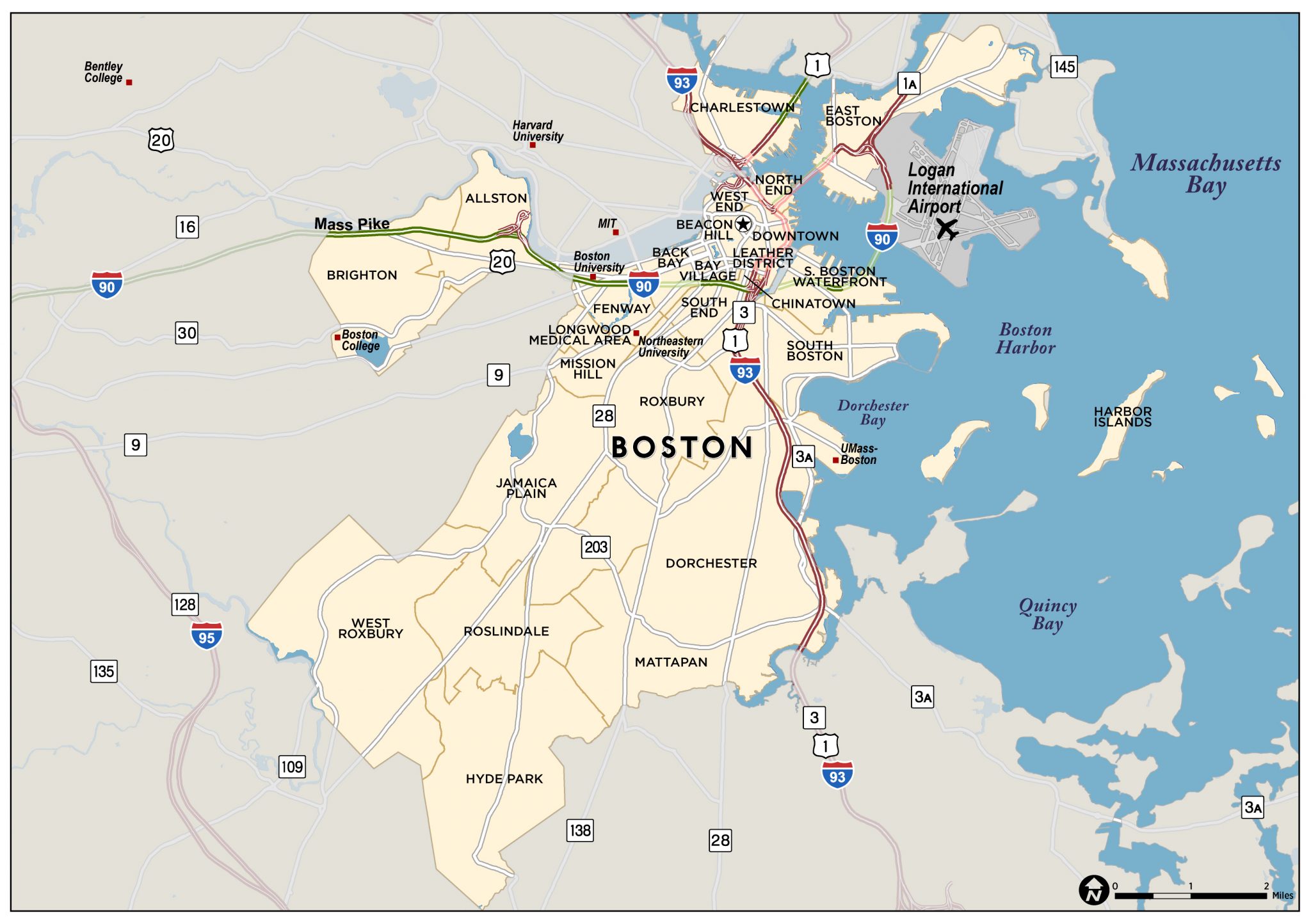Boston Urban
The Retail Market
The Boston Urban retail market is one of the most dynamic and diversified urban markets in the United States. Whether it is the world renowned street retail on Newbury Street in Boston’s Back Bay, Harvard Square in Cambridge, iconic urban retail projects such as Boston’s Prudential Center and Faneuil Hall, the 500,000 square feet of retail anchoring the Assembly Row mixed used development in Somerville, the 1,100,000 square feet of retail at the Seaport Square mixed use development in the Seaport District, the chef driven restaurants and retail that will be a part of Wynn Boston Harbor Resort and Casino in Everett, or the redevelopment of Meadow Glen Mall in Medford anchored by Wegman’s, Boston Urban retail is thriving in both historic legacy locations and new build developments.
Neighborhoods that previously had very little residential base are now changing significantly with the trend towards living in urban environments creating residential densities where none existed before. Prominent examples of this are plentiful in the Boston Urban markets. Boston’s Downtown Crossing neighborhood, sandwiched between the eastern edge of the Boston Common and the western edge of the Financial District, struggled for decades to regain the glory days of when shoppers flocked to the area for the department stores Jordan Marsh and Filene’s as well as the original location of Filene’s Basement. That hustle and bustle which has been missing for so long is now back. Gone are the vestiges of the Combat Zone, Boston’s adult entertainment district, which for decades thrived along Washington Street at the southern end of Downtown Crossing. Today there is the 1,800,000 square foot Ritz Carlton Hotel and Towers; the 60 story Millennium Tower, downtown Boston’s tallest building with 442 condominium units priced from $1,000,000 to over $10,000,000 and street level retail anchored by a 25,000 square foot Roche Bros. supermarket and Primark Boston, a 77,000 square foot, four level store from the Dublin based fast fashion retailer; Emerson College’s historic and award winning renovation of the 600 seat Paramount Theater; storefronts filled with a variety of local, regional and national retailers; daily pedestrian counts of 250,000 along Washington Street; and a neighborhood population now estimated at over 10,000 residents.
Boston’s Fenway neighborhood, whose only previous notoriety was when the Red Sox were playing home games at Fenway Park, has exploded with midrise & high rise residential developments over the past decade. Along with this influx of residents is a burgeoning retail scene from local restaurants to the 160,000 square foot, four level Target that anchors the street level retail portion of Van Ness, a 550,000 square foot mixed use property that also includes 172 residential units and 240,000 sf of office space. Likewise, Boston’s South End neighborhood is also experiencing a transformation.
Once considered to be on the wrong side of the Mass Pike for development to be successful, the South End has now become an affordable alternative to living in the Back Bay, Downtown or The Seaport. As residents have filled in the neighborhood many local restaurant operators have found a new home in the South End. Anchoring the South End’s revival is the Ink Block mixed use development. Formerly the headquarters of the Boston Herald newspaper, Ink Block sits on six acres with 315 apartments, 150 condominiums, a 200 room AC Hotel by Marriott and street level retail anchored by a 50,000 sf Whole Foods Market. The success of Ink Block has been transformational for the South End as numerous other mixed use projects are now following Ink Block’s success.
As residential projects continue to be built and be successful throughout Urban Boston new retail opportunities are opening up in places never before considered as viable for retail. Although this trend is most prevalent throughout the city of Boston, it is happening throughout all the Boston Urban communities as urban living becomes the preferred choice of a larger section of today’s population.
Grocery stores operating in the market include Stop & Shop, Star Market, Market Basket, Wegman’s, bfresh, Whole Foods, Roche Bros., Trader Joe’s, Aldi, Price Rite, and Save A Lot.
PetSmart - Gateway Center - Everett, MA
WhichWich - Assembly Row - Somerville, MA
The Economy
The most significant employment clusters of Urban Boston market are primarily focused on the cities of Boston and Cambridge. This dynamic economy has a high agglomeration of industries such as education, science, technology, healthcare and engineering due to the large concentration of universities, including world renowned MIT and Harvard University. These create highly productive environment’s that facilitate the growth of significant research and development initiatives on everything from healthcare, life science, pharmaceuticals, biotech and robotics, to social media, cyber security, ad tech and business analytics. In particular, the Kendall Square section of Cambridge has had tremendous employment growth in these science and technology related industries. Downtown (Financial District), North End, Fenway, South End, South Boston (Southie), Seaport, Back Bay and Allston are the neighborhoods within the City of Boston that are the largest employment centers and also experiencing the most new development. These areas are filled with employment clusters of various financial services industries such as investment management, venture capital, private equity, insurance, accounting, legal, banking and mutual funds.
Employment growth in Urban Boston is not only from major relocations from outside the state such as GE’s corporate headquarters relocation from Fairfield, CT into 390,000 square feet in Boston’s Ft. Point neighborhood that will house 800 employees. Growth is also occurring from firms currently located in Boston’s suburbs such as Reebok’s global headquarters move of 700 employees from Canton, MA to 220,000 square feet in the Innovation and Design Building in Boston’s Seaport District and Converse’s headquarters relocation of 400 employees from North Andover, MA, to 185,000 square feet of space at Lovejoy Wharf in Boston’s North End. In making their decision to relocate to Boston all three companies indicated that the ability to more easily attract young, creative, technical talent in Boston’s urban environment was primary in their thought process. Nowhere is this talent more easily found then at tech companies such as Google, Microsoft and Amazon who continue to grow in Boston and Cambridge. While most tech and life science companies prefer to be in Cambridge due to its’ proximity to MIT and Harvard, Boston has become an attractive alternative due to lack of space in Kendall Square in Cambridge. While Microsoft and Google each have over 300,000 square feet of office space and 800 employees each in their Cambridge offices, Amazon has 2,000 employees in one office in Kendall Square and two offices in Boston. It is becoming increasingly common for major Silicon Valley tech firms to have Cambridge and Boston as a significant East Coast hub.
The largest industry in the city of Boston is health care. Five of the ten largest employers in Boston are hospitals: Massachusetts General Hospital, Brigham and Women’s Hospital, Boston Children’s Hospital, Beth Israel Deaconess Medical Center, and Boston Medical Center. The medical schools for both Tufts University and Harvard University are located in Boston with Massachusetts General Hospital being the major teaching hospital for Harvard Medical School and Tufts Medical Center for the Tufts University School of Medicine. Boston University’s School of Medicine is also located in Boston, with Boston Medical Center its primary teaching affiliate. Although hospitals are major employers in most major metro areas, Boston hospitals provide a unique economic base to the city due the prestige of the universities these hospitals are affiliated with and the type of research dollars and research talent these hospitals can attract. For the 22nd year in a row, Boston led the nation in total dollars of National Institute of Health (NIH) funding. In FY2016, Boston received a total of $1.85 billion, with its nearest competitor being New York City, which received $1.63 billion.
The overflow from this growth is being felt in adjacent cities such as Somerville with the 825,000 square new headquarters building at Assembly Row for Partners Healthcare and the $2.1 billion Wynn Boston Harbor Resort and Casino in Everett currently under construction for a 2019 opening. With these nearby brain strongholds, the economy is at the forefront of the innovation and collaboration that is changing the world. Venture capital continues to have a large presence within the city of Boston for this very reason alone. They have access to tremendous opportunities from the burgeoning group of entrepreneurs that these environments produce.
Urban Boston is one of the top 10 tourist attractions in the United States. Its’ litany of historic landmarks, from the 50 acre Boston Common (established in 1634, it is the oldest public recreation area in the country) to Bunker Hill (“do not fire until you see the whites of their eyes”), to the Paul Revere house (built in 1680 – it is the oldest building in Boston), to the USS Constitution (launched in 1797 it is the oldest commissioned warship still afloat), to the Old North Church (the launch point for Paul Revere’s ride – “one if by land, and two if by sea”) make Urban Boston a unique tourist destination. Boston’s place in American history combined with its’ sophistication as one of today’s greatest knowledge based economies supported by over 2,000 restaurants, hundreds of hotels, along with world class entertainment venues and some of the country’s most iconic professional sports teams make Boston a destination for over 18,000,000 visitors annually, with an annual economic impact in excess of $10,000,000,000.
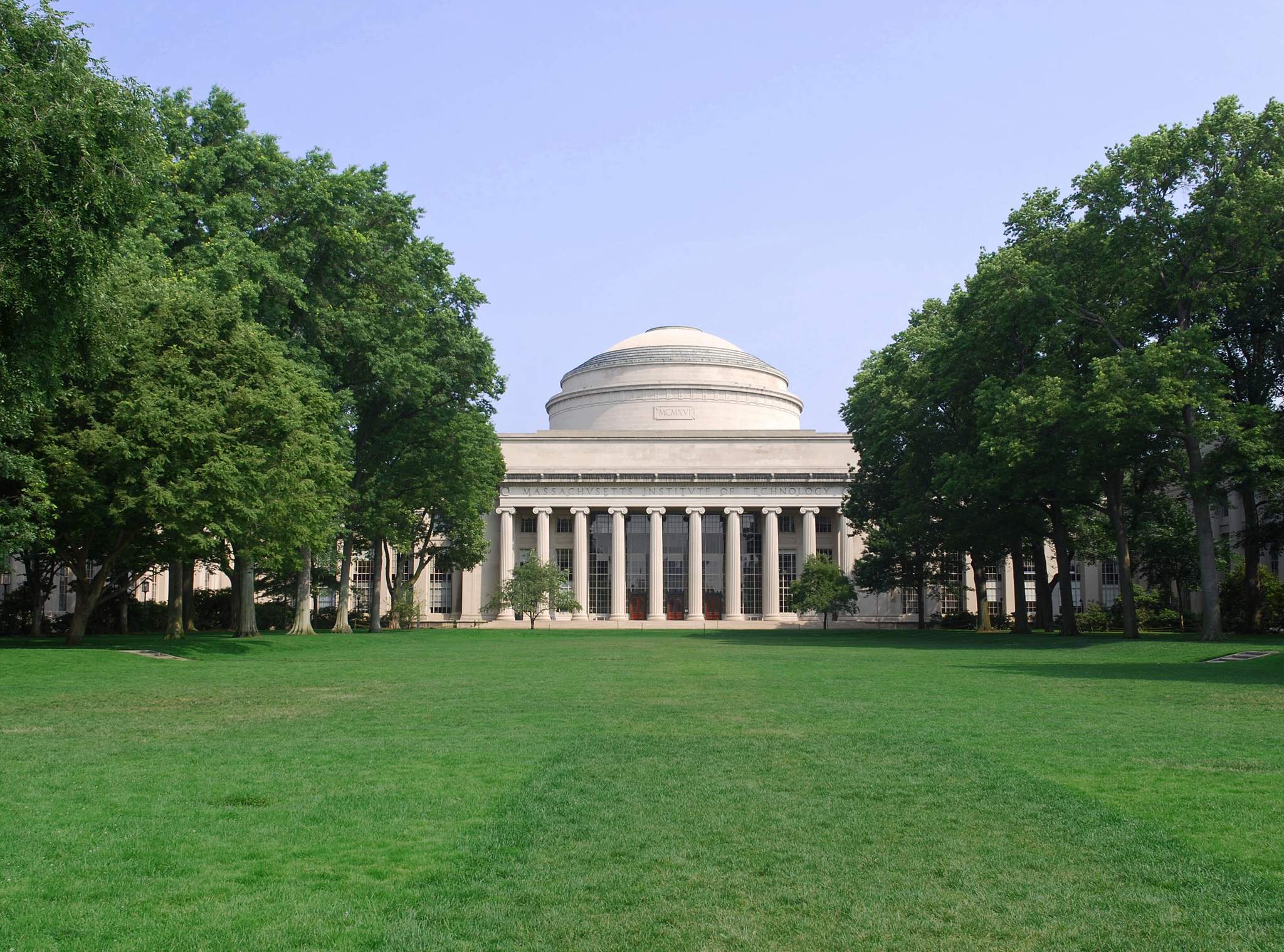
MIT – Cambridge, MA
Area colleges and enrollment
| Berklee College of Music | Boston | 4,900 |
| Boston Conservatory at Berklee | Boston | 800 |
| Boston University | Boston | 33,000 |
| Emerson College | Boston | 3,500 |
| Emmanuel College | Boston | 2,500 |
| Fisher College | Boston | 1,900 |
| Harvard University | Cambridge | 22,000 |
| Lesley University | Cambridge | 2,500 |
| Massachusetts College of Art & Design | Boston | 2,000 |
| Massachusetts College of Pharmacy | Boston | 7,100 |
| Massachusetts Institute of Technology | Cambridge | 11,300 |
| Northeastern University | Boston | 19,900 |
| Suffolk University | Boston | 8,100 |
| Tufts University | Medford | 11,800 |
| Wentworth Institute of Technology | Boston | 3,900 |
| Wheelock College | Boston | 1,200 |
| TOTAL | 136,400 |
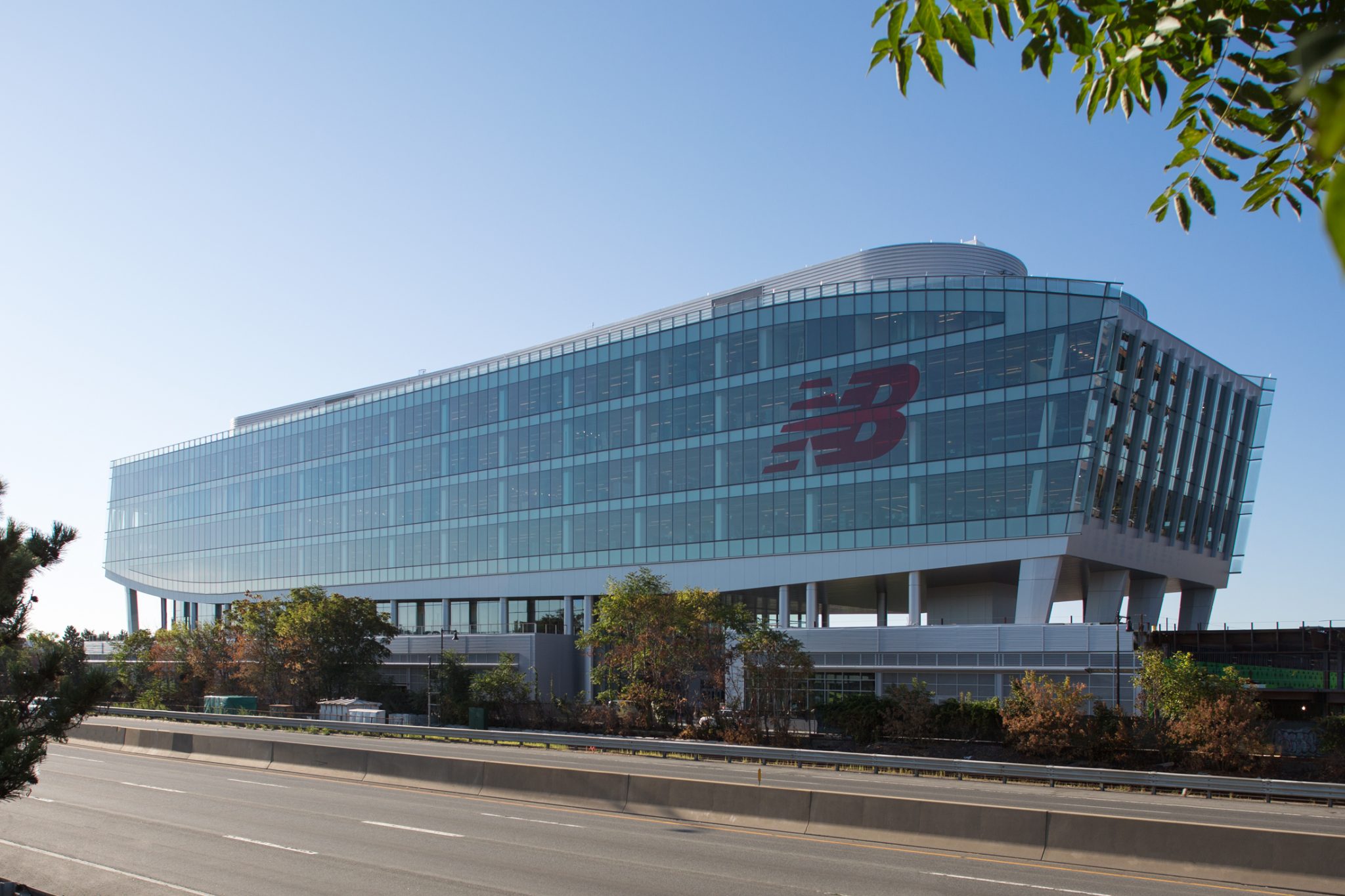
New Balance Headquaters - Brighton, MA
Major Employers
| Allen & Gerritsen | Advertising Agency | Boston |
| Hill Holiday | Advertising Agency | Boston |
| Arnold World Wide | Advertising Agency | Boston |
| DigitasLBi | Advertising Agency | Boston |
| Mullen Lowe | Advertising Agency | Boston |
| Shire – Biogen | Biotech | Cambridge |
| Biogen | Biotech | Cambridge/Boston |
| Merck | Biotech | Cambridge |
| Moderna Therapeutics | Biotech | Cambridge |
| Novartis | Biotech | Cambridge |
| Pfizer | Biotech | Cambridge |
| Sanofi Genzyme | Biotech | Cambridge |
| Sarepta Therapeutics | Biotech | Cambridge |
| Takeda Pharmaceuticals | Biotech | Cambridge |
| Vertex Pharmaceuticals | Biotech | Boston |
| Alnylam Pharmaceuticals | Biotech | Cambridge |
| Foundation Medicine | Biotech | Cambridge |
| Ironwood Pharmaceuticals | Biotech | Cambridge |
| Agios Pharmaceuticals | Biotech | Cambridge |
| Momenta Pharmaceuticals | Biotech | Cambridge |
| Pearson | Education Products and Services | Boston |
| BNY Mellon | Financial Services | Boston |
| Brown Brothers Harriman & Co. | Financial Services | Boston |
| Federal Reserve Bank of Boston | Financial Services | Boston |
| Fidelity Investments | Financial Services | Boston |
| John Hancock | Financial Services | Boston |
| Liberty Mutual | Financial Services | Boston |
| Prudential | Financial Services | Boston |
| Putnam Investments | Financial Services | Boston |
| Wellington Management | Financial Services | Boston |
| LPL Financial | Financial Services | Boston |
| MFA Investment Management | Financial Services | Boston |
| Amundi Pioneer | Financial Services | Boston |
| Eaton Vance | Financial Services | Boston |
| Cambridge Associates | Financial Services | Boston |
| Plymouth Rock Group | Financial Services – Auto and Homeowner’s Insurance | Boston |
| Lexington Insurance Company (AIG) | Financial Services – Property and Casualty Insurance | Boston |
| Beth Israel Deaconess Medical Center | Health Care | Boston |
| Boston Children’s Hospital | Health Care | Boston |
| Brigham and Women’s Hospital | Health Care | Boston |
| Dana Farber Cancer Insitute | Health Care | Boston |
| Massachusetts General Hospital | Health Care | Boston |
| Boston Medical Center | Health Care | Boston |
| Tuft’s Medical Center | Health Care | Boston |
| Joslin Diabetes Center | Health Care | Boston |
| New Balance | HQ – Athletic Footwear and Apparel | Boston (Brighton) |
| Gillette Corporation | HQ – Consumer Products | Boston |
| General Electric | HQ – Corporate Offices – Digial/Industrial | Boston |
| Thomas Reuters | News Media and Information Services | Boston |
| Technology | Cambridge | |
| IBM Watson Health | Technology – Cloud Computing for Health Care and Life Science | Cambridge |
| Akamai Technologies | Technology – Content Delivery Network and Cloud Computing Services | Cambridge |
| Amazon | Technology – E-commerce | Boston/Cambridge |
| Wayfair.com | Technology- E-commerce – Home Furnishings and Decor | Boston |
| Technology – Social Media | Cambridge | |
| Pegasystems | Technology – Software – Customer Relationship Management and Business Process Management | Cambridge |
| Hubspot | Technology – Software – Inbound Marketing and Sales | Carmbridge |
| Logmein | Technology – Software – Remote Connectivity and Collaboration | Boston |
| WordStream | Technology – Software – Targeted Online Advertising | Boston |
| Acquia | Technology – Software – Web Content Management and Customer Engagement | Boston |
| Microsoft | Technology – Software and Hardware – Research and Development Center | Cambridge |
| Bain Capital | Venture Capital | Boston |
| Charles River Ventures | Venture Capital | Cambridge |
| Highland Capital Partners | Venture Capital | Cambridge |
| Openview Venture Partners | Venture Capital | Boston |
| Thomas H. Lee Partners | Venture Capital | Boston |
The Seaport
The Seaport is the newest neighborhood rising on the south Boston waterfront, with 10 million square feet developed in the last 15 years and over 7 million square feet currently under development, it is the intersection of culture, industry, and commerce; making The Seaport one of the highest profile urban core development sub-markets in the United States. In a city known for its historic roots, rich in character, this new neighborhood aims to emulate the success of Boston’s history while looking forward to the future by creating the ultimate live work play environment with a focus on the next 100 years.
Until the completion of The Big Dig in 2006, The Seaport did not even exist as one of Boston’s official neighborhoods, it was previously part of South Boston (Southie) and was primarily surface parking lots that provided lower priced parking for Downtown (Financial District) office buildings. Separated from Downtown by the elevated portion of I-93, these surface parking lots were considered remote from prime Downtown real estate and as such, were thought to have little significant long term development value. That all changed however, when it became clear that The Big Dig was going to become a reality. The Big Dig is the result of decades of hard work by both public and private industries, beginning with its’ planning in the early 1980’s and its’ completion of construction in 2007. The Big Dig was a $24 billion public infrastructure project that rerouted, and buried parts of the Mass. Pike (I-90) and I-93 going through Downtown Boston. Rerouting and burying the Mass Pike created a more direct route to Boston Logan International Airport, relieved traffic congestion, and freed up grade level land for higher and better uses. As for I-93, by burying the interstate going through Downtown Boston, new real estate opportunities were created that made these surface parking lots no longer divided from Downtown Boston by an elevated and deteriorating I-93.
The result was the creation of The Seaport neighborhood, 600 acres of predominately surface parking lots with frontage along the Boston waterfront that were now connected to Downtown by the Rose Fitzgerald Kennedy Greenway; a 15 acre, 1.5 mile long linear park that was built in place of the elevated portion of I-93 and above the newly constructed underground section of I-93. In addition to benefitting Downtown and The Seaport, the completed Big Dig also connected many other Boston neighborhoods that were previously subdivided by the highway, including the West End, the North End, Chinatown and the Leather District as well as to a lesser extent Beacon Hill and the South End. Heralded by Boston’s longest serving Mayor, Thomas Menino (1993 – 2014), The Big Dig unlocked billions of dollars in real estate value for the City of Boston, connected the city’s neighborhoods, and invigorated private development. Dubbed “The Innovation District”, the aim of The Seaport is to create a tech hub to rival that of Cambridge and build on the areas already strong industry cluster.
Today, The Seaport is thriving, with millions of square feet of office, residential and retail projects completed thus far, and millions more at various stages of development. Many companies are opening offices or relocating headquarters to the area, such as Vertex Pharmaceuticals and Goodwin Proctor LLP opening in Fan Pier, with others such as Fidelity Investments and John Hancock opening offices here as well. The ultimate endorsement of the Seaport as the future of Boston’s innovation economy, and that of the greater country, is the decision by General Electric (GE) to relocate its global headquarters to Fort Point, on the edge of the Seaport and Downtown Boston, because of its attractive highly educated workforce and the synergies generated by the greater Boston economy for its businesses.
With all of this development activity, the Seaport is now also home to many famed first class restaurants, including Legal Harborside, Tony C’s Seaport, Morton’s Steak House, Legal Test Kitchen, Del Frisco’s, Mastro’s Ocean Club and Strega Waterfront. With the completion of WS Developments 7.68 million square foot mixed use Seaport Square project over the next few years, The Seaport will welcome 1.1 million square feet of additional retail space. Seaport Square will be The Seaport’s most ambitious project and will insure the goal of The Seaport becoming a self-sustaining 24/7 Boston neighborhood where people can live, work, shop and dine with every possible necessity and amenity at their disposal. Adding to an already eclectic mix of uses in The Seaport are the local flavor of Harpoon Brewery and Beer Hall as well as the Blue Hills Bank Pavilion, a 5,000 seat outdoor amphitheater on the Boston Waterfront that hosts concerts and live music from popular artists such as Stevie Wonder, Van Morrison, Nora Jones and The Allman Brothers Band.
-
Boston Convention and Exhibition Center
-
Institute of Contemporary Art
-
Liberty Wharf
-
World Trade Center
The Geography

Crewing on The Charles
City & Town Populations
| Urban Boston Population |
1,057,000 |
| Boston | 662,000 |
| Cambridge | 111,000 |
| Somerville | 81,000 |
| Brookline | 62,000 |
| Medford | 60,000 |
| Everett | 44,000 |
| Chelsea | 37,000 |
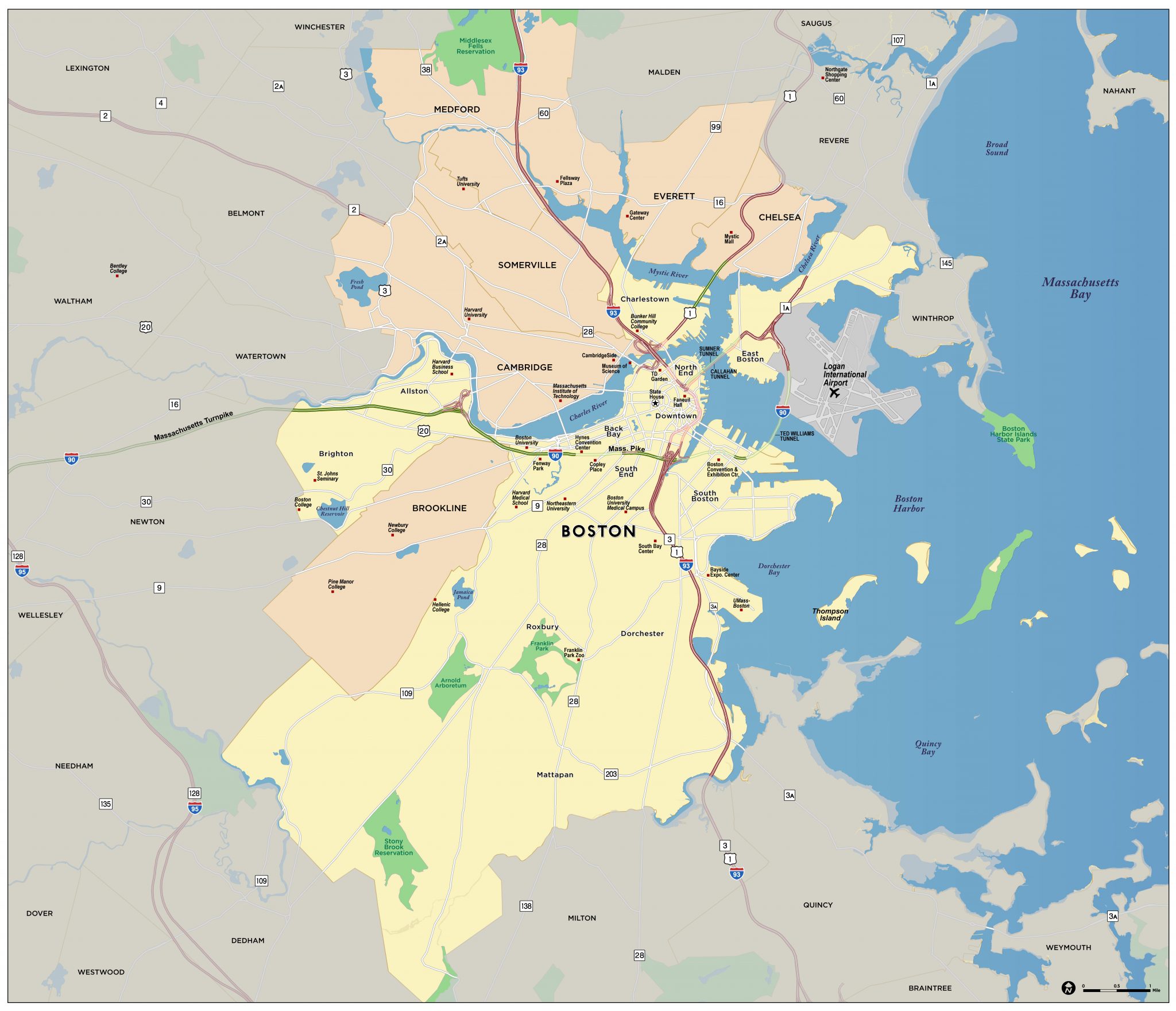
The Neighborhoods
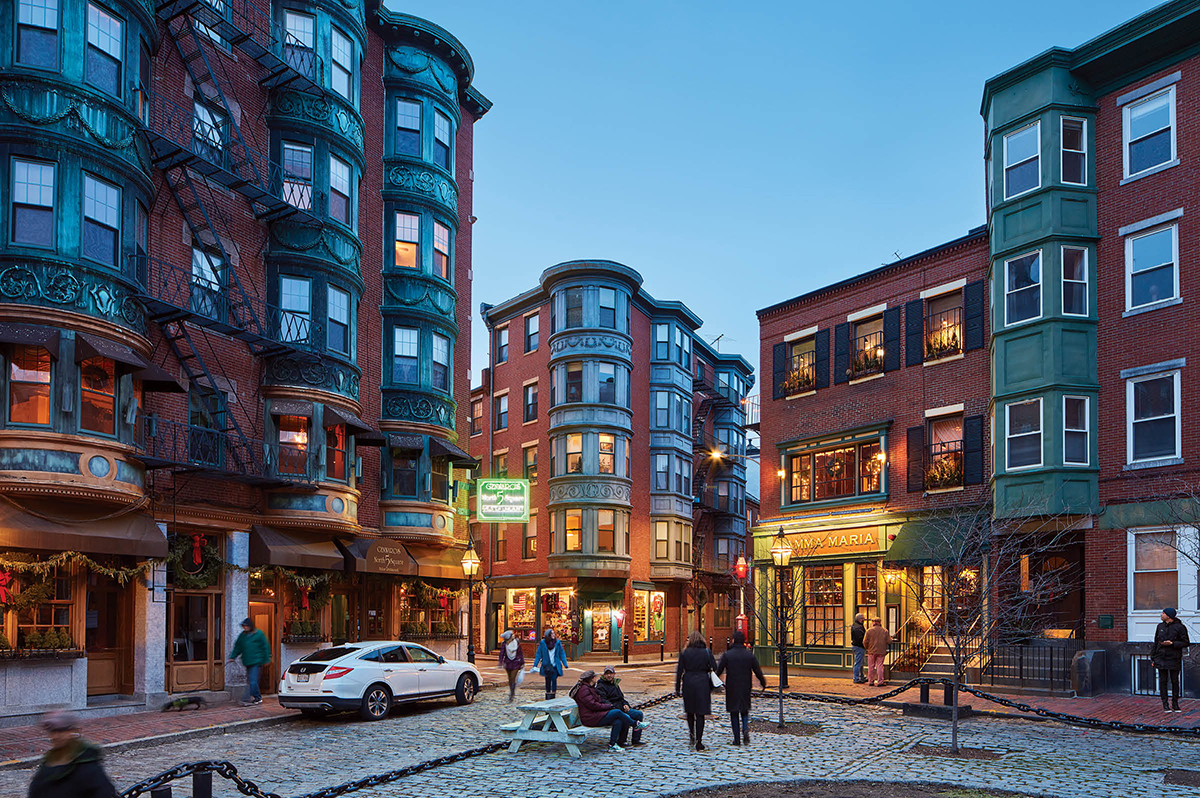
The North End
Boston's 26 Neighborhoods
| Allston | Back Bay |
| Bay Village | Beacon Hill |
| Brighton | Charlestown |
| Chinatown | Dorchester |
| Downtown | East Boston |
| Fenway | Harbor Islands |
| Hyde Park | Jamaica Plain |
| Leather District | Longwood Medical Area |
| Mattapan | Mission Hill |
| North End | Roslindale |
| Roxbury | South Boston |
| South Boston Waterfront | South End |
| West End | West Roxbury |
